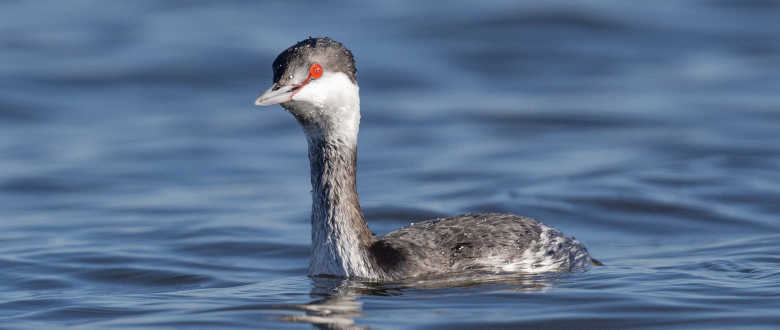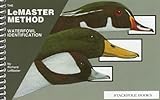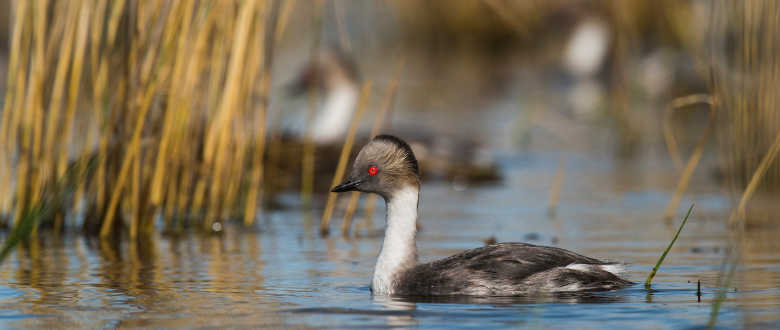Can you hunt grebe? You may have seen a strange bird recently while duck hunting that looks like a duck, but something about it just isn’t right. Chances are, you may have just seen a grebe.
Grebes are a federally protected migratory bird that can’t be hunted in the U.S. The fine for shooting a grebe can range from $500 – $4,000. Grebes are secretive birds that prefer to swim rather than fly and are commonly misidentified on duck hunts.
In this guide we’ll discuss the most common types of grebes, how they differ from ducks, and why you should avoid them on your next duck hunt.
![]()

- Can you hunt Grebe?
- What is a Grebe?
- The Eight North American grebe species:
- How do you identify a grebe vs a duck?
- What should you do if you see a Grebe while duck hunting?
- What ducks look like grebes?
- The most common duck species mistaken for grebes:
- States where Grebes are protected:
- Tips for identifying grebes while duck hunting:
- Bottom Line
Can you hunt Grebe?
Grebes are a protected species in most U.S. states under the migratory bird act. They can’t be hunted and doing so could result in stiff penalties. Due to the close resemblance of a grebe to a duck, it is imperative that you verify identification before taking a shot. Mistakes could be costly.
Need help identifying ducks? Check out the Lemaster Waterfowl Identification Method. It’s an informative book that outlines key details to look for when identifying North American waterfowl species.  It’s a very informative book on how to learn to identify waterfowl with great pictures and methods. It’s a good learning tool for the beginner and a great reference tool to keep around.
It’s a very informative book on how to learn to identify waterfowl with great pictures and methods. It’s a good learning tool for the beginner and a great reference tool to keep around.
What is a Grebe?
Grebes are not ducks. They are from the family Podicipedidae which contains eight grebe species found in North America. The most common type of grebe in the continental U.S. is the pied-billed grebe (Podilymbus Podiceps) followed by the horned grebe (Podiceps auratus).
While grebes are similar in appearance to ducks, there are several key differences. First, the webbing on grebes feet is not traditionally webbed like ducks, it is lobed. Secondly, grebes can’t walk on land due to their legs being positioned further back on their bodies.
If anything, grebes are built and behave in the water more like diving ducks. They prefer to dive rather than fly and to actually see them flying is rare. Grebes move slow on the water, but are fast swimmers below the surface and prefer to feed on submerged aquatic vegetation.
The Eight North American grebe species:
Here’s a great video showing what grebes look like in the wild
Video from Cornell_lab Youtube Channel on the Pied-billed Grebe
How do you identify a grebe vs a duck?
There are several ways to identify grebes while duck hunting to avoid mistaking it for a duck. The first tell tale sign of a grebe is that they are alone. Grebes are solitary birds that tend to keep to themselves. If you see one small duck like bird sitting on a piece of water alone, it may be a grebe.
Secondly, grebes prefer not to fly. Grebes would rather dive than fly to escape predators. If you see a bird who’s first instinct is to dive when approached and not fly away like a duck, then the bird is likely a grebe.
The last method for identifying grebes is their physical characteristics. The body shape of a grebe when on water is that of a small body and long neck. Most duck species have short necks and rarely extend them on water. Some grebes have red eyes and beaks rather than bills which makes distinguishing between it and ducks even easier.
SUMMARY
Grebes aren’t ducks and can’t be hunted. They are protected under the Migratory Bird Act. They live mostly solitary lives, unlike ducks, and dive rather than fly when disturbed.
What should you do if you see a Grebe while duck hunting?
Seeing a grebe which duck hunting is a common occurrence since their migratory alignment is similar. Grebes spend the majority of their lives on water and feed on the same aquatic vegetation that many ducks do. For these reasons, ducks and grebes can often comingle.
If you happen to see a grebe while hunting, leave it alone and avoid disturbing it. Grebes prefer to do their own thing and will almost always pick avoidance rather than confrontation. Simply let them go on their way and make note that grebes are in the area and extra attention should be given to avoiding mistaking them for a duck.
What ducks look like grebes?
Grebes such as the pied-billed grebe and horned grebe are small in size, weigh less than 1 pound and are around 10-inches in length from tip of bill to the edges of the tail feathers. Several large duck species such as Mallards, Pintails, Gadwalls, and Widgeon are way too large to be mistaken for a grebe.
Smaller duck species are most commonly mistaken for grebes, especially in low light conditions. Diving ducks with their similar low water profile are also high on the list.
The most common duck species mistaken for grebes:
- Ruddy Duck
- Blue-winged Teal
- Green-winged Teal
- Bluebill (hen)
- Red head (hen)
- Canvasback (hen)
- Ringneck (hen)
States where Grebes are protected:
Below is a list of states where grebes are protected and gebe hunting is not allowed:
- Alabama
- Alaska
- Arizona
- Arkansas
- California
- Colorado
- Connecticut
- Delaware
- Florida
- Georgia
- Hawaii
- Idaho
- Illinois
- Indiana
- Iowa
- Kansas
- Kentucky
- Louisiana
- Maine
- Maryland
- Massachusetts
- Michigan
- Minnesota
- Mississippi
- Missouri
- Montana
- Nebraska
- Nevada
- New Hampshire
- New Jersey
- New Mexico
- New York
- North Carolina
- North Dakota
- Ohio
- Oklahoma
- Oregon
- Pennsylvania
- Rhode Island
- South Carolina
- South Dakota
- Tennessee
- Texas
- Utah
- Vermont
- Virginia
- Washington
- West Virginia
- Wisconsin
- Wyoming
As you can see, grebe hunting is outlawed in all states where federal migratory bird protections are in place. Grebes are not considered game birds and if you see them while hunting avoid disturbing them.

Tips for identifying grebes while duck hunting:
- If you can’t identify it, don’t shoot
- If it’s one bird and it refuses to fly, it’s likely a grebe
- Grebes have a long neck, small body, and sit low in the water
- The flight tempo of grebes is clumsy and not smooth like a duck
- The wings of a gebe are shorter than a duck
- Some grebes have red eyes
- Grebes are not vocal and won’t respond to calling
It is easy to tell the difference between grebes and ducks if you know what to look for. Whereas most ducks will flush when spooked, grebes will not. They dive. Grebes are clumsy in flight unlike a duck which is smooth with little wasted effort.
Grebes will not respond to calling and do not decoy into duck spreads. They are more likely to swim by than to land in a duck spread. If you can’t identify a bird while duck hunting, it’s always better to not shoot than make a costly mistake.
Bottom Line
Grebes are often mistaken for ducks while duck hunting and it can lead to a costly misstep for most waterfowl hunters. Grebes are federally protected which makes being able to distinguish between it and a duck while hunting is extremely important. See the Lemaster Waterfowl Identification Method booklet for tips and tricks for easily indentifying waterfowl in flight.
The most common of the eight grebe species found in the U.S. are the pied-billed grebe and the horned grebe. These two grebe species have the largest distribution and are found in the Pacific, Central, Mississippi, and Atlantic flyways.
Grebes are often found alone and prefer to dive instead of fly when in danger. Grebes resemble several small duck species such as teal and ruddy ducks, but the key differences are the long neck, red eyes, and unwillingness to fly.
Was this helpful?
Search Chokes by Gauge
Related Posts
- Best Waterfowl Choke Tubes for 2024, Expert Picks

- Choke Tube Diameter and Constriction Table

- 5 Easy Ways to Remove a Stuck Choke Tube

Last update on 2025-12-03 / Affiliate links / Product Images from Amazon Product Advertising API



